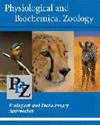Body Composition and Energy Savings by Hibernation: Lessons from the South American Marsupial Dromiciops gliroides
IF 1.8
3区 生物学
Q3 PHYSIOLOGY
引用次数: 4
Abstract
Hibernation (i.e., seasonal or multiday torpor) has been described in mammals from five continents and represents an important adaptation for energy economy. However, direct quantifications of energy savings by hibernation are challenging because of the complexities of estimating energy expenditure in the field. Here, we applied quantitative magnetic resonance to determine body fat and body composition in hibernating Dromiciops gliroides (monito del monte). During an experimental period of 31 d in winter, fat was significantly reduced by 5.72±0.45 g, and lean mass was significantly reduced by 2.05±0.14 g. This fat and lean mass consumption is equivalent to a daily energy expenditure of hibernation (DEEH) of 8.89±0.6 kJ d−1, representing 13.4% of basal metabolic rate, with a proportional contribution of fat and lean mass consumption to DEEH of 81% and 18%, respectively. During the deep heterothermic bouts of monitos, body temperature remained 0.41°C ± 0.2°C above ambient temperature, typical of hibernators. Animals shut down metabolism and passively cool down to a critical defended temperature of 5.0°C ± 0.1°C, where they begin thermoregulation in torpor. Using temperature data loggers, we obtained an empirical estimation of minimum thermal conductance of 3.37±0.19 J g−1 h−1 °C−1, which is 107% of the expectation by allometric equations. With this, we parameterized body temperature/ambient temperature time series to calculate torpor parameters and metabolic rates in euthermia and torpor. Whereas the acute metabolic fall in each torpor episode is about 96%, the energy saved by hibernation is 88% (compared with the DEE of active animals), which coincides with values from the literature at similar body mass. Thus, estimating body composition provides a simple method to measure the energy saved by hibernation in mammals.冬眠的身体组成和能量节约:来自南美有袋动物的经验教训
冬眠(即季节性或多日性冬眠)已在五大洲的哺乳动物中被描述,代表着对能源经济的重要适应。然而,由于估计该领域能源支出的复杂性,直接量化冬眠节省的能源具有挑战性。在这里,我们应用定量磁共振来测定冬眠的Dromiciops gliroides(monitor del monte)的体脂和身体成分。在冬季31天的实验期间,脂肪显著减少了5.72±0.45 g,瘦质量显著减少了2.05±0.14 g。这种脂肪和瘦质量的消耗相当于冬眠(DEEH)的每日能量消耗8.89±0.6 kJ d−1,占基础代谢率的13.4%,脂肪和瘦物质消耗对避蚊胺的比例贡献分别为81%和18%。在深度异温监测期间,体温保持在比环境温度高0.41°C±0.2°C的水平,这是冬眠动物的典型特征。动物停止新陈代谢,被动冷却到5.0°C±0.1°C的临界防御温度,在那里它们开始迟钝地进行体温调节。使用温度数据记录器,我们获得了最小热导率3.37±0.19 J g−1 h−1°C−1的经验估计,这是异速测量方程预期值的107%。据此,我们参数化了体温/环境温度时间序列,以计算体温过低和体温过低时的体温过低参数和代谢率。尽管每次冬眠的急性代谢下降约为96%,但冬眠所节省的能量为88%(与活动动物的避蚊胺相比),这与文献中在类似体重下的数值一致。因此,估计身体成分为测量哺乳动物冬眠所节省能量提供了一种简单的方法。
本文章由计算机程序翻译,如有差异,请以英文原文为准。
求助全文
约1分钟内获得全文
求助全文
来源期刊
CiteScore
3.20
自引率
6.20%
发文量
62
审稿时长
6-12 weeks
期刊介绍:
Physiological and Biochemical Zoology: Ecological and Evolutionary Approaches primarily publishes original research in animal physiology and biochemistry as considered from behavioral, ecological, and/or evolutionary perspectives. Studies at all levels of biological organization from the molecular to the whole organism are welcome, and work that integrates across levels of organization is particularly encouraged. Studies that focus on behavior or morphology are welcome, so long as they include ties to physiology or biochemistry, in addition to having an ecological or evolutionary context.
Subdisciplines of interest include nutrition and digestion, salt and water balance, epithelial and membrane transport, gas exchange and transport, acid-base balance, temperature adaptation, energetics, structure and function of macromolecules, chemical coordination and signal transduction, nitrogen metabolism and excretion, locomotion and muscle function, biomechanics, circulation, behavioral, comparative and mechanistic endocrinology, sensory physiology, neural coordination, and ecotoxicology ecoimmunology.

 求助内容:
求助内容: 应助结果提醒方式:
应助结果提醒方式:


